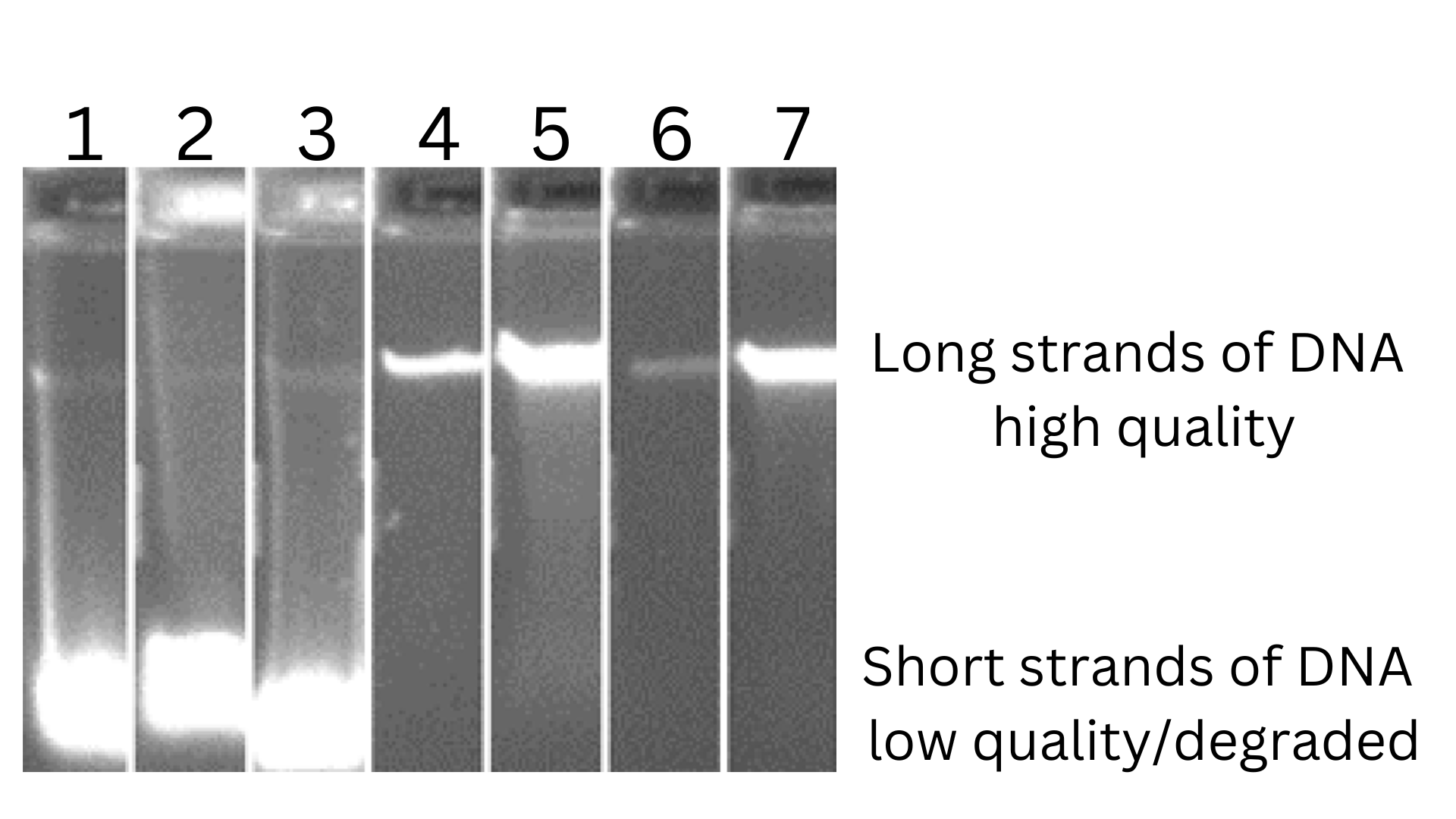Plan Bee aims to produce Estimated Breeding Values that will give an indication of how a queen performs for a trait in comparison to other queens due to her genetic makeup. This requires that colonies be evaluated for traits and that we either have a pedigree or can work out relationships from genetic testing. Genetic testing is better than pedigree because we know the relatedness, e.g. which queens are half-sisters and which are full-sisters. This improves the accuracy of the Estimated Breeding Values resulting in a faster rate of selection for the traits that you want to improve.
Plan Bee has been working with bee breeders in New South Wales, Victoria, Tasmania, South Australia, Western Australia and Queensland to collect samples for genetic testing.
Figure 1 shows 7 DNA samples extracted from multiple drones. Each DNA samples is loaded into a well/lane in an agarose gel and then an electric current is run through the gel. Small degraded pieces of DNA pass through quickly and travel faster. This is shown in lanes 1-3. Long pieces of DNA, which are of high quality, pass more slowly and travel less far, like that in lanes 4-7.
How bright the band is indicates how much DNA is there – the yield. Yield is also important because we need enough DNA to work with.

Figure 1. Each of the 7 samples were loaded onto a lane on a gel and an electric current passed through it. Short, degraded DNA passes through the gel fast (lanes 1-3). High quality long strands of DNA pass more slowly (lanes 4-7). The yield of DNA that has been extracted is indicated by the brightness of the bands.
Long strands of DNA are required for genetic testing. So how do we get high quality DNA?
The first step is to get good quality samples. A fact sheet on how to take samples for genetic testing has been produced by Plan Bee . The most important thing is to keep the samples as cold as possible. This stops enzymes from chopping the DNA into shorter pieces.

Figure 2. We collected different aged drone pupae to see if there are some ages that produce better quality or a higher yield of DNA than others. Photo credit: Erica Mo
We wanted to know if different aged drones produce different quality DNA (Figure 2). We collected many drones of all pupal stages from 3 colonies. We found that we can get good quality DNA from all pupal stages. We are now doing genetic testing so that we can compare the results from different stages – do we get data from a similar number of genetic markers regardless of age?
We realise that it isn’t always possible to choose a certain age of drone – but if there is a choice then we will know which ones are the best to sample by doing this testing.
We also investigated if different tissues used in the DNA extraction affected quality. We found that heads consistently yield a lot of high-quality DNA compared to thorax and legs. We’ll be doing genetic testing on the different tissue types to determine how yield affects the quality of the results.
The next step is to optimise the DNA extraction procedure. We’ve been working on this for some time now. We have trialled 3 different procedures either ourselves or with our service provider. Two of them produced degraded DNA like that in the first 3 lanes of the gel above (Figure 1). The 3rd procedure produced DNA like that in the last 4 lanes of the gel above for ~95% of samples. This procedure costs 6 times as much as the others. However, it will be worth it because without good enough quality DNA we can’t proceed to genetic testing.
We know that those of you that have contributed samples to Plan Bee are anxiously awaiting your results. We didn’t want to waste your precious samples using techniques that we couldn’t be sure would work. You will be happy to know that we are working to improve our procedures and produce the best results possible. Thank you for your patience.
Other information:
Acknowledgements:
- Plan Bee (National Honey Bee Genetic Improvement Program) is supported by funding from the Australian Government Department of Agriculture, Fisheries and Forestry as part of its Rural Research and Development for Profit program. The project is further supported by AgriFutures Australia, the Department of Regional NSW, University of Sydney, University of New England Animal Genetics and Breeding Unit, Better Bees WA Inc, Wheen Bee Foundation, Costa Group, Olam, Beechworth Honey, Monson’s Honey and Pollination, South Pacific Seeds, Australian Queen Bee Breeders Association, Australian Honey Bee Industry Council, and commercial beekeepers.
- This article was peer-reviewed by Emily Remnant and Erica Mo.


